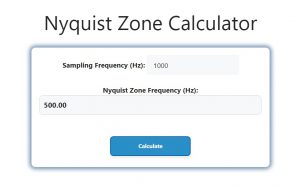About Nyquist Zone Calculator (Formula)
The Nyquist Zone Calculator is a valuable tool for engineers and scientists working with signal processing. It helps determine the Nyquist frequency, which is crucial for accurately sampling signals without introducing aliasing. By understanding the Nyquist theorem, users can make informed decisions regarding the sampling rate needed for their applications.
Formula
The formula for calculating the Nyquist Zone Frequency (NZ) is:
Nyquist Zone Frequency (NZ) = Sampling Frequency (Fs) / 2.
This equation highlights that the Nyquist frequency is half the sampling frequency, providing the maximum frequency that can be accurately sampled.
How to Use
Using the Nyquist Zone Calculator is straightforward:
- Input the Sampling Frequency (Fs): Enter the desired sampling frequency of the signal you want to analyze.
- Calculate: The calculator will automatically compute the Nyquist Zone Frequency (NZ) based on the provided sampling frequency.
- Interpret the Results: The calculated frequency indicates the upper limit of the signal frequencies that can be accurately sampled without aliasing.
Example
Let’s say you have a sampling frequency of 1000 Hz. Using the formula:
NZ = Fs / 2 = 1000 Hz / 2 = 500 Hz.
This means that the Nyquist Zone Frequency for this sampling rate is 500 Hz. Thus, signals with frequencies up to 500 Hz can be sampled without distortion.

FAQs
1. What is the Nyquist Zone?
The Nyquist Zone refers to the frequency range between two consecutive Nyquist frequencies, where signal sampling occurs without aliasing.
2. Why is the Nyquist frequency important?
The Nyquist frequency is essential for preventing aliasing, which can distort the sampled signal and lead to inaccurate data representation.
3. How do I determine the appropriate sampling frequency?
The appropriate sampling frequency should be at least twice the highest frequency of the signal to adhere to the Nyquist theorem.
4. Can I use the Nyquist Zone Calculator for audio signals?
Yes, the Nyquist Zone Calculator is commonly used in audio signal processing to determine the proper sampling rates for recording and playback.
5. What happens if I sample below the Nyquist frequency?
Sampling below the Nyquist frequency can result in aliasing, where higher frequency signals appear as lower frequencies in the sampled data.
6. Is there a maximum limit for the sampling frequency?
While there is no strict maximum limit, sampling frequencies should be chosen based on the application and the capabilities of the hardware being used.
7. How does the Nyquist Zone relate to digital signal processing?
In digital signal processing, the Nyquist Zone helps define the frequency limits for accurate signal representation and prevents distortion.
8. Can the Nyquist Zone Calculator handle non-linear signals?
The calculator is primarily designed for linear signals, but the principles of the Nyquist theorem apply to all types of signals.
9. What is aliasing in signal processing?
Aliasing occurs when higher frequency signals are misrepresented as lower frequencies due to insufficient sampling rates.
10. How can I avoid aliasing in my projects?
To avoid aliasing, ensure your sampling frequency is at least twice the highest frequency component of the signal you wish to capture.
11. Is the Nyquist Zone Calculator applicable for video signals?
Yes, the calculator can also be applied to video signals, where frame rates need to be considered to avoid temporal aliasing.
12. What software tools can I use alongside the Nyquist Zone Calculator?
Many digital signal processing software packages, such as MATLAB or Python libraries, can complement the use of a Nyquist Zone Calculator.
13. Do all signals require the same sampling frequency?
No, different signals have different frequency components, so the sampling frequency should be adjusted according to the specific characteristics of each signal.
14. How does oversampling relate to the Nyquist frequency?
Oversampling involves sampling at a rate significantly higher than the Nyquist frequency, which can improve signal quality and reduce aliasing.
15. Can I use the Nyquist Zone Calculator for real-time applications?
Yes, the calculator can assist in determining sampling rates for real-time signal processing applications to ensure accurate representation.
16. What role does bandwidth play in the Nyquist Zone?
Bandwidth is critical in determining the highest frequency of a signal, which directly influences the required sampling frequency according to the Nyquist theorem.
17. Are there limitations to the Nyquist Zone Calculator?
The calculator assumes ideal conditions and may not account for real-world factors like noise or non-linearities in signal processing.
18. What is the relationship between sampling rate and resolution?
Higher sampling rates can improve resolution, capturing more detail in the signal, while lower rates may miss important frequency components.
19. Can I calculate multiple Nyquist zones for a single signal?
Yes, multiple Nyquist zones can be calculated based on different sampling frequencies to analyze the signal’s behavior across various frequency ranges.
20. How can I validate the results from the Nyquist Zone Calculator?
Validate the results by comparing them with known characteristics of the signal and ensuring they meet the Nyquist theorem requirements.
Conclusion
The Nyquist Zone Calculator is an essential tool for anyone involved in signal processing, offering valuable insights into sampling frequencies and preventing aliasing. By understanding and applying the concepts of the Nyquist theorem, users can enhance their signal analysis and ensure accurate data representation.